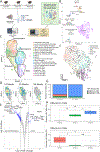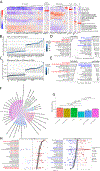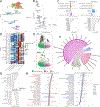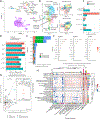An exhausted-like microglial population accumulates in aged and APOE4 genotype Alzheimer's brains
- PMID: 38159571
- PMCID: PMC10805152
- DOI: 10.1016/j.immuni.2023.12.001
An exhausted-like microglial population accumulates in aged and APOE4 genotype Alzheimer's brains
Abstract
The dominant risk factors for late-onset Alzheimer's disease (AD) are advanced age and the APOE4 genetic variant. To examine how these factors alter neuroimmune function, we generated an integrative, longitudinal single-cell atlas of brain immune cells in AD model mice bearing the three common human APOE alleles. Transcriptomic and chromatin accessibility analyses identified a reactive microglial population defined by the concomitant expression of inflammatory signals and cell-intrinsic stress markers whose frequency increased with age and APOE4 burden. An analogous population was detectable in the brains of human AD patients, including in the cortical tissue, using multiplexed spatial transcriptomics. This population, which we designate as terminally inflammatory microglia (TIM), exhibited defects in amyloid-β clearance and altered cell-cell communication during aducanumab treatment. TIM may represent an exhausted-like state for inflammatory microglia in the AD milieu that contributes to AD risk and pathology in APOE4 carriers and the elderly, thus presenting a potential therapeutic target for AD.
Keywords: APOE; Alzheimer's disease; TIM; microglia; single cell.
Copyright © 2023 Elsevier Inc. All rights reserved.
Conflict of interest statement
Declaration of interests S.F.T. is a cofounder, shareholder, and member of the scientific advisory board of Inspirna.
Figures







Comment in
-
TIMely connections: APOE4, aging, and Alzheimer's.Immunity. 2024 Jan 9;57(1):8-10. doi: 10.1016/j.immuni.2023.12.015. Immunity. 2024. PMID: 38198855
References
-
- Hammond TR, Dufort C, Dissing-Olesen L, Giera S, Young A, Wysoker A, Walker AJ, Gergits F, Segel M, Nemesh J, et al. (2018). Single-Cell RNA Sequencing of Microglia throughout the Mouse Lifespan and in the Injured Brain Reveals Complex Cell-State Changes. Immunity 50, 253–271.e6. 10.1016/j.immuni.2018.11.004. - DOI - PMC - PubMed
Publication types
MeSH terms
Substances
Grants and funding
LinkOut - more resources
Full Text Sources
Medical
Molecular Biology Databases
Miscellaneous

